

Harmony. Barbershop quartets, such as this US Navy group, sing 4-part pieces, made up of a melody line (normally the lead) and 3 harmony parts.
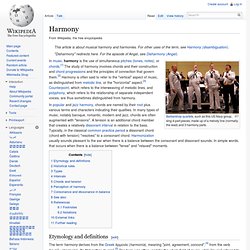
Etymology and definitions[edit] The term harmony derives from the Greek ἁρμονία (harmonía), meaning "joint, agreement, concord",[4] from the verb ἁρμόζω (harmozo), "to fit together, to join".[5] The term was often used for the whole field of music, while "music" referred to the arts in general. In Ancient Greece, the term defined the combination of contrasted elements: a higher and lower note.[6] Nevertheless, it is unclear whether the simultaneous sounding of notes was part of ancient Greek musical practice; "harmonía" may have merely provided a system of classification of the relationships between different pitches. In the Middle Ages the term was used to describe two pitches sounding in combination, and in the Renaissance the concept was expanded to denote three pitches sounding together.[6] Historical rules[edit] Types[edit] Close position C major triad. Melody. The true goal of music—its proper enterprise—is melody.

All the parts of harmony have as their ultimate purpose only beautiful melody. Key signature. Although a key signature may be written using any combination of sharp and flat symbols, about a dozen diatonic key signatures are by far the most common, and their use is assumed in much of this article.
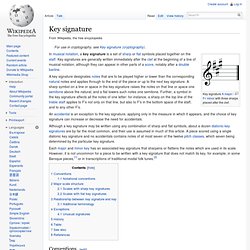
A piece scored using a single diatonic key signature and no accidentals contains notes of at most seven of the twelve pitch classes, which seven being determined by the particular key signature. Conventions[edit] B major scale: no key signature; accidentals required throughout B major scale: key signature; accidentals not needed In principle, any piece can be written with any key signature, using accidentals to correct the pattern of whole and half steps. In a score containing more than one instrument, all the instruments are usually written with the same key signature. Scale (music) Pattern of intervals in the C-major scale Play A measure of the width of each scale step provides a method to classify scales.
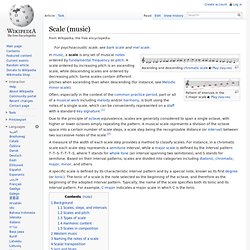
For instance, in a chromatic scale each scale step represents a semitone interval, while a major scale is defined by the interval pattern T–T–S–T–T–T–S, where T stands for whole tone (an interval spanning two semitones), and S stands for semitone. Based on their interval patterns, scales are divided into categories including diatonic, chromatic, major, minor, and others. Scales are typically listed from low to high.
Tempo. Play In musical terminology, tempo ("time" in Italian; plural: tempi or tempos) is the speed or pace of a given piece.

Measuring tempo[edit] Electronic metronome, Wittner model The tempo of a piece will typically be written at the start of a piece of music, and in modern Western music is usually indicated in beats per minute (BPM). This means that a particular note value (for example, a quarter note or crotchet) is specified as the beat, and that the amount of time between successive beats is a specified fraction of a minute. With the advent of modern electronics, BPM became an extremely precise measure. As an alternative to metronome markings, some 20th-century composers (such as Béla Bartók and John Cage) would give the total execution time of a piece, from which the proper tempo can be roughly derived. Tempo is as crucial in contemporary music as it is in classical. Musical vocabulary for tempo[edit] A Seth Thomas model metronome. Tone. Chord (music) Mussorgsky's Pictures at an Exhibition "Promenade", is a piece showing an explicit chord progression.
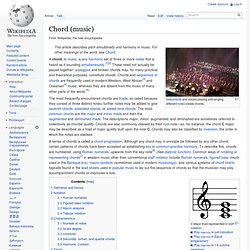
(Nattiez 1990, p. 218) Play In the medieval era, early Christian hymns featured organum (which used the simultaneous perfect intervals of a fourth, a fifth, and an octave[13]), with chord progressions and harmony an incidental result of the emphasis on melodic lines during the medieval and then Renaissance (15-17th centuries).[7][14] The Romantic period, the 19th century, featured increased chromaticism.[7] Composers began to use secondary dominants in the Baroque, and they became common in the Romantic period.[19] Many contemporary popular Western genres continue to rely on simple diatonic harmony, though far from universally:[20] notable exceptions include the music of film scores, which often use chromatic, atonal or post-tonal harmony, and modern jazz (especially circa 1960), in which chords may include up to seven notes (and occasionally more).[21] Macro analysis for triads on C.
Dynamics (music) Teacher.
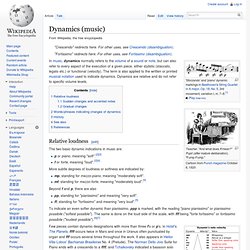
"And what does ff mean? "Pupil (after mature deliberation). "Fump-Fump. " The two basic dynamic indications in music are: p or piano, meaning "soft".[2][3]f or forte, meaning "loud".[2][4] More subtle degrees of loudness or softness are indicated by: mp, standing for mezzo-piano, meaning "moderately soft".mf, standing for mezzo-forte, meaning "moderately loud".[5] Beyond f and p, there are also.